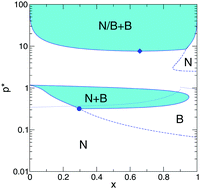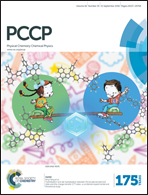Biaxial nematic phase stability and demixing behaviour in monolayers of rod–plate mixtures†
Abstract
We theoretically study the phase behaviour of monolayers of hard rod–plate mixtures using a fundamental-measure density functional in the restricted-orientation (Zwanzig) approximation. Particles can rotate in 3D but their centres of mass are constrained to be on a flat surface. In addition, we consider both species to be subject to an attractive potential proportional to the particle contact area on the surface and with adsorption strengths that depend on the species type. Particles have board-like shape, with sizes chosen using a symmetry criterion: same volume and same aspect ratio κ. Phase diagrams were calculated for κ = 10, 20 and 40 and different values of adsorption strengths. For small adsorption strengths the mixtures exhibit a second-order uniaxial nematic–biaxial nematic transition for molar fraction of rods 0 ≤ x ≲ 0.9. In the uniaxial nematic phase the particle axes of rods and plates are aligned perpendicular and parallel to the monolayer, respectively. At the transition, the orientational symmetry of the plate axes is broken, and they orient parallel to a director lying on the surface. For large and equal adsorption strengths the mixture demixes at low pressures into a uniaxial nematic phase, rich in plates, and a biaxial nematic phase, rich in rods. The demixing transition is located between two tricritical points. Also, at higher pressures and in the plate-rich part of the phase diagram, the system exhibits a strong first-order uniaxial nematic–biaxial nematic phase transition with a large density coexistence gap. When rod adsorption is considerably large while that of plates is small, the transition to the biaxial nematic phase is always of second order, and its region of stability in the phase diagram considerably widens. At very high pressures the mixture can effectively be identified as a two-dimensional mixture of squares and rectangles which again demixes above a certain critical point. We also studied the relative stability of uniform phases with respect to density modulations of smectic, columnar and crystalline symmetry.



 Please wait while we load your content...
Please wait while we load your content...